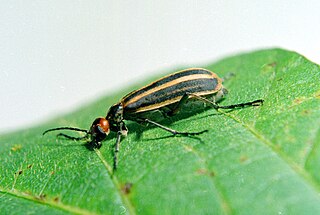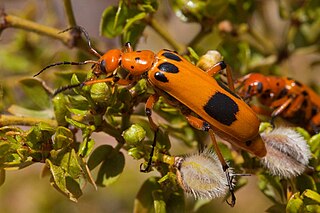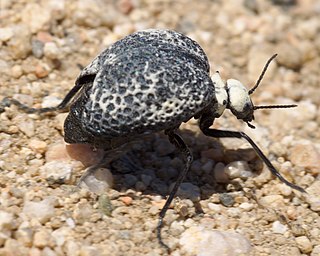
Blister beetles are beetles of the family Meloidae, so called for their defensive secretion of a blistering agent, cantharidin. About 7,500 species are known worldwide. Many are conspicuous and some are aposematically colored, announcing their toxicity to would-be predators.

Epicauta vittata is a species of beetle in the family Meloidae, the blister beetles. It is native to eastern North America, including eastern Canada and the eastern United States. It is known commonly as the striped blister beetle and the old-fashioned potato beetle. It is known as an agricultural pest.

Meloinae is a subfamily of beetles in the family Meloidae. There are at least 330 described species in Meloinae.
Epicauta atrata is a species of blister beetle in the family Meloidae. It is found in Central America and North America. This species is generally characterized by a red head, and an all black body. They attack the eggs of Epicauta vittata, a crop pest found in the East Coast.
Pyrota tenuicostatis, the red-margined blister beetle, is a species of blister beetle in the family Meloidae. It is found in Central America and North America.
Pyrota fasciata is a species of blister beetle in the family Meloidae. It is found in Central America and North America.
Tetraonyx quadrimaculata is a species of blister beetle in the family Meloidae. It is found in the Caribbean Sea and North America.

Pyrota postica is a species of blister beetle in the family Meloidae. It is found in Central America and North America.

Eupomphini is a tribe of blister beetles in the family Meloidae. There are about 7 genera and more than 20 described species in Eupomphini.
Pyrota punctata is a species of blister beetle in the family Meloidae. It is found in Central America and North America.
Pyrota sinuata is a species of blister beetle in the family Meloidae. It is found in North America.

Megetra is a genus of blister beetles in the family Meloidae. There are at least three described species in Megetra.
Eupompha edmundsi is a species of blister beetle in the family Meloidae. It is found in North America.
Megetra cancellata is a species of blister beetle in the family Meloidae. It is found in Central America and North America.
Pyrota concinna is a species of blister beetle in the family Meloidae. It is found in Central America and North America.
Pyrota akhurstiana is a species of blister beetle in the family Meloidae. It is found in North America.
Pyrota discoidea is a species of blister beetle in the family Meloidae. It is found in North America.
Eupompha imperialis is a species of blister beetle in the family Meloidae. It is found in North America.

Cysteodemus armatus, the inflated blister beetle, is a species of blister beetle in the family Meloidae. It is found in Central America and North America. The wing covers, which are mostly glabrous, are inflated to the point of almost covering part of the thorax. They are black, densely spotted with white. The elytra are fused along the middle, meaning that the beetle cannot fly.

Pyrota palpalis, the Charlie Brown blister beetle, is a species of blister beetle in the family Meloidae. It is found in Central America and North America.







